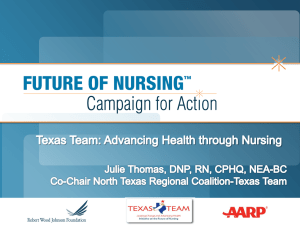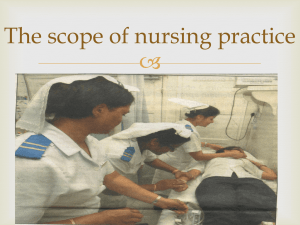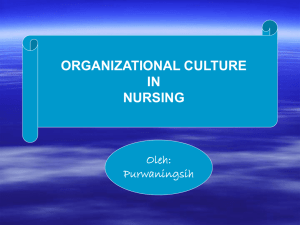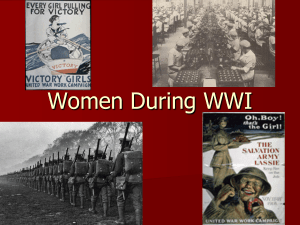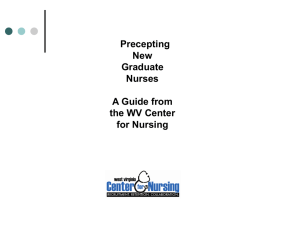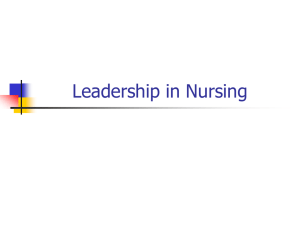From Novice to Leader * An Unexpected Journey
advertisement
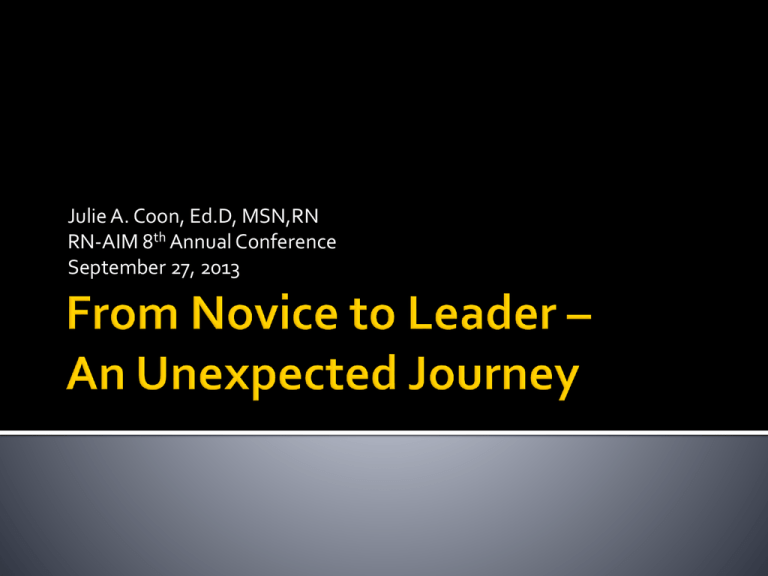
Julie A. Coon, Ed.D, MSN,RN RN-AIM 8th Annual Conference September 27, 2013 To explore the reasons that leadership tends to be “unexpected” rather than an intentional component of role development in nursing. To examine a personal leadership journey as an academic nurse leader in terms of insights gained along the way. To identify evidence-based strategies to increase leadership capacity, competency & intent among novice nurses. What do today’s nursing students tell us? Poll of 120 FSU Nursing students asked: ▪ What would your dream job be upon graduation? ▪ What is your long term goal for your nursing career? Critical Care: ICU / ED (32) Pediatrics / NICU (30) OB / L&D (21) Med Surg (17) Travel Nurse (9) Public Health/Home Health (5) Ambulatory Care (2) Psych (1) Military (1) Unsure /Just get a job! (9) Nurse Practitioner / Midwife (41) CRNA (21) Charge Nurse in desired specialty (9) Nursing Administration (6) Nurse Educator / Researcher (8) Community based (5) Earn a MS in Nursing (9) Earn a Doctorate in Nursing (8) Other: Unsure or Misc. answers with only 1-2 responses (26) No stated aspirations to become… A Nurse Executive A Nursing Faculty Coordinator or Chair A Nursing Dean or Director An expert in public policy A leader in their professional organization An elected or appointed member of a governmental entity Let’s explore that “unintended” journey to better understand how it has happened historically. A personal journey of a once reluctant leader…from nursing school to academic leadership Nursing as a career choice (1970-72) Undergraduate nursing education (1972-75) Graduate Nurse to Nurse Manager (1975-80) Graduate nursing education – MSN (1980-82) Trial in ambulatory care as a CNS (1981-82) Entry to academia & the faculty role (1982-2001) Administration – where the action is (2001-?) Director to Interim Dean and back again (2010-12) The last challenge (2013 - ?) Informal recognition from people I respected Opportunities to be innovative in practice settings – clinical & academic Formal recognitions & awards Opportunities to participate in nursing reform We all think that we aren’t worthy of leading no matter what our stage of development. Leadership is often thrust upon the “Last Woman Standing” which only reinforces our reluctance and sense of not being worthy. All new leaders are scared to death and suffer from the “imposter” syndrome. Your nursing education experiences really do matter. An administrator has to “manage” as well as lead, i.e., The “Red Ball” phenomenon. Without formal training for leadership, finding the right mentor is critical. Leadership succession is a challenge. Leadership is where the real fun is...but like nursing, it is never if finished product. This is not a new question – the literature is prolific in this topic from a generic context. (Burns, Bennis & Nannis, Starratt, Covey, Sergiovanni, Cleary, Kouzes & Posner, etc.) If you Google “Leadership Lessons”…. Colin Powell and FDR to Spiderman and the Janitor! Keep your ends certain, but your means flexible. You are usually stronger when you work through others. Reach out to your opponents. Curiosity is a good thing. The most important leadership quality is courage. What is the value of exemplary leadership? Study by Salanova, Lorente, Chambel & Martinez (2011) linking TFL to nurses’ extra role performance, self-efficacy and work engagement. NM with a TFL style enhanced ‘extra-role’ performance in nurses, increasing hospital efficacy. A direct relationship between transformational leadership and work engagement was also found. Study by Casida, Crane, Walker & Wargo (2012): Elaboration of Leadership and Culture in High Performing Nursing Units of Hospitals as perceived by Staff Nurses (SN) ▪ SN at BSN or higher level had more favorable / different perceptions of their NM leadership than diploma or ADN SN ▪ The frequent portrayals of TFL behaviors (i.e., visionary) by NM were paramount in shaping culture traits that exemplify high performance, are flexible and adaptive. Downey, Parslow & Smart (2011) described informal leaders as the “hidden treasure” in nursing leadership. Informal Leaders are the most underutilized asset in health care (approximately 80-90% of a typical HC organization). If identified early, they can be developed and empowered to impact environmental culture in a positive manner Traits to watch for: Ubiquitous – everywhere at the same time Expert nurses who share their knowledge Those names that always come up to lead teams or volunteer Recognized amongst their peers Elevate the whole team – pull us together Credibility with both staff and administration High performers / strong work ethic Sense of the heartbeat of their unit and want to make it better – they want to be part of the discussion in shaping the organization They do not usually view themselves as special or even as leaders They may accept acknowledgement or rewards for their accomplishments, but may oppose any formal title or visible recognition. Give them opportunities to show they can solve problems – chair a task force, etc. Be mindful to not overuse them to prevent burnout; select projects carefully Informal Leaders need to know that their positive attitude and creative contributions are of great value to the NA and the unit/org. Simple day to day recognitions are often most highly valued. Eddy, Doutrich, Higgs, Spuck, Olson & Weinberg (2009) conducted a qualitative study to elicit narratives about essential nursing leadership competencies to inform the revision of a graduate nursing program: Communication Skills: listening & conflict resolution The ability to communicate a vision, motivate and inspire Technological adroitness & Fiscal dexterity The courage to be proactive during rapid change Stiles, Pardue, Young & Morales (2011) examined the process of becoming a nurse faculty leader and found that advancing reform was a significant experience: Being able to envision oneself in the leadership role Being involved with others in a common cause or goal Serving as a symbol and preserving authenticity Creating an environment for change Crosby & Shields (2010) convened a task force of leaders from academia and practice to address succession planning. Noted that as HC has become less hierarchal, leadership is less about position and more about influence. Also noted the correlation between how staff perceive the NM and job satisfaction / work effectiveness. Current environmental pressures are influencing the pool of future nurses & highlight the need for strong leadership. Led to the development of leadership academy workshops in the clinical setting to address these needs. Anazor (2012) reported on a program developed by the International Council of Nurses (ICN) to develop the Leadership for Change (LFC) program to complement leadership education programs from different countries to enhance nurse’s skills to prepare them to meet the challenges posed by ongoing health reforms and empower them to contribute to decision-making. Participate effectively in health policy development and decision-making. Be effective leaders and managers in nursing health services. Prepare future nurse managers and leaders for key positions. Influence change in nursing curricula so future nurse leaders are prepared appropriately. Scott & Miles (2013) provide a framework for viewing the current strategies in both education and practice to address the potential shortage of nurse leaders. This call to advance leadership capacity and competence in nursing has never been louder or more urgent than it is today. Although the public is not used to viewing nurses as leaders and not all nurses begin their career with thoughts of becoming a leader, all nurses must be leaders in the design, implementation and evaluation of, as well as advocacy for, the ongoing reforms to the system that will be needed. Additionally, nurses will need leadership skills and competencies to act as full partners with physicians and other health professionals in redesign and reform efforts across the health care system. (Institute of Medicine. The Future of Nursing; Leading Change, Advancing Health. Washington, DC, National academies Press; 2010) Education: Note that most nursing literature on leadership is devoted to “leader” development rather than “leadership” development. Efforts must be made to augment faculty and students’ conceptualization of nursing such that leadership is seen as a dimension of practice for all nurses, not just those in formal leadership roles. Education to Practice: A comprehensive conceptual framework for lifelong leadership development of nurses needs to be designed. A baseline leadership capacity (novice) to build upon in all nurses regardless of their nursing role. Example: We have done this for quality & safety education for nurses…but not for leadership. We lack the evidence base for teaching leadership. Leadership vs. Management Leader vs. Leadership AACN Essentials – no consistent framework Collective wisdom would suggest that leadership should be shared, participative and relational. Shared leadership vs. leadership as a role Moving to adopt leadership in nursing as both a process AND a role promotes the potential for all nurses to develop leadership competency and capacity. As more nurses perceive themselves as being able to lead; more will be inspired to become leaders in formal roles, i.e.,SUCCESSION! Hannah (2006) as cited in Scott & Miles (2013) conceptualized a model the highlights the components that influence whether or not a person identifies him- or herself as able to lead – from developmental readiness to Leader selfefficacy. Leadership self-efficacy: The level of confidence in the knowledge, skills and abilities associated with leading others. Self-confidence is the most prevalent characteristic used in defining a leader. Include opportunities for students to develop desire for and participate in successful leadership experiences. One path to an administrative position in nursing began when managers told nurses they think they would be good in leadership. We need to TELL them!!! Students need to be exposed to nurses who are passionately addressing issues in health care in both formal and informal roles of leadership so they are aroused to consider leadership as a course of action for resolving challenges in health care. Acknowledge that nursing equals leadership Admit that leadership takes time to develop Don’t hesitate to “pretend” to be a leader Leadership development must be a feature of every work setting and professional association. Nurses need to be transformational leaders Nurses need to be capable of strategic vision If you’re going to have a vision, it might as well be for excellence Transformative leadership requires that nurses shape more than the purview of nursing Nurses need to seize the opportunities handed to them. Source: McBride, A. (2011) Taking leadership seriously. American Journal of Nursing, 111 (3), 11. Julie A. Coon, Ed.D, MSN Associate Dean College of Health Professions Ferris State University coonj@ferris.edu Anazor C. (2012) Preparing nurse leaders for global health reforms. Nursing Management, 19 (4), 26-28. Casida J., Crane P., Walker T. & Wargo, L. (2012) Elaboration of leadership and Culture in high-performing nursing units of hospitals as perceived by staff nurses. Research and Theory for Nursing Practice: An International Journal, 26 (4), 241-261. Crosby F. & Shields C. (2010) Preparing the next generation of nurse leaders: An educational needs assessment. The Journal of Continuing Education in Nursing, 41 (8), 363-368. Downey M., Parslow S., & Smart, M. (2011) The hidden treasure in nursing leadership: Informal leaders. Journal of Nursing Management, 19, 517-521. Eddy,L., Doutrich, D., Higgs, Z, Spuck, J, Olson, M. & Weinberg, S. (2009) Relevant nursing leadership: An evidence-based programmatic response. International Journal of Nursing Education Scholarship, 6 (1), 1-17. Institute of Medicine (2010) The Future of Nursing; Leading Change, Advancing Health. Washington, DC, National academies Press. McBride, A. (2011) Taking leadership seriously. American Journal of Nursing, 111 (3), 11. Salanova M., Lorente L., Chambel M. & Martinez I. (2011) Linking Transformational leadership to nurses’ extra-role performance: The mediating role of self-efficacy and work engagement. Journal of Advanced Nursing, 67 (10), 2256-2266. Scott E. & Miles J. (2013) Advancing leadership capacity in nursing. Nursing Administration Quarterly 37 (1), 77-82. Stiles K., Pardue K., Young P. & Morales M. (2011) Becoming a nurse faculty leader: Practices of leading illuminated through advancing reform in nursing education. Nursing Forum 46 (2), 9-101.

